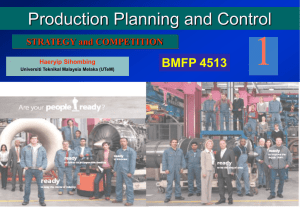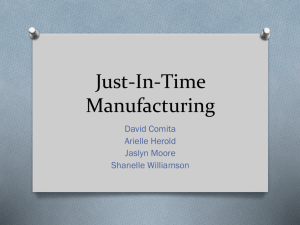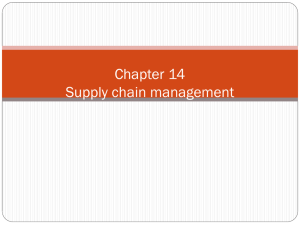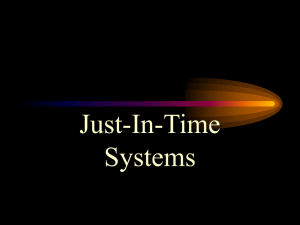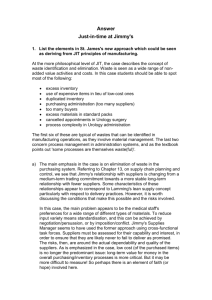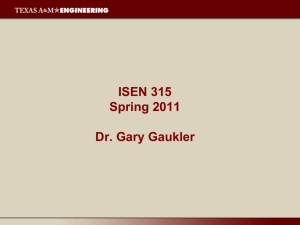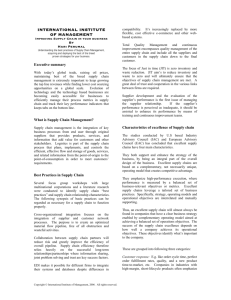PRODUCTIONS/OPERATIONS MANAGEMENT
advertisement
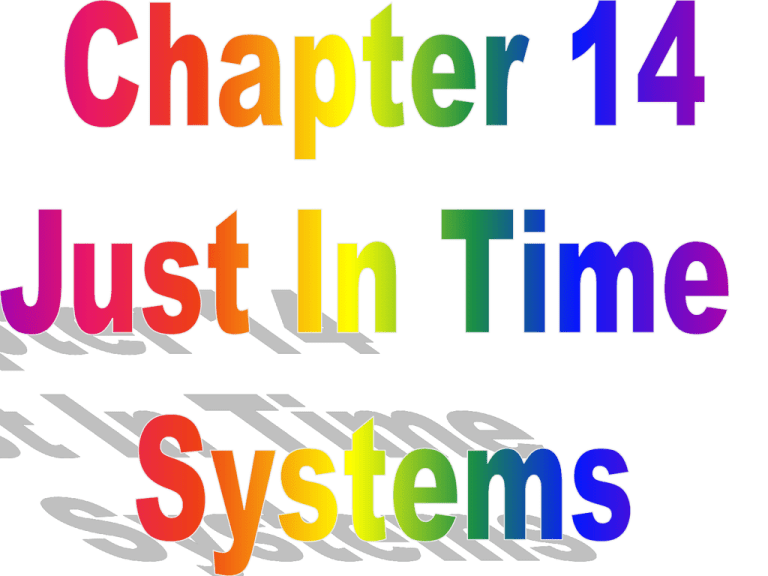
Final Exam • A total of 33 questions. • Chapter 11 • Chapter 12 • Chapter 13 • Chapter 14 ( 3 blank filling qualitative questions) • 30 quantitative multiple choice questions on Ch 11, 12, 13 Just In Time (JIT) • A production system in which processing and movement of materials and products are carefully timed and occur just as they are needed, usually in small batches. • The next small batch arrives as the preceding batch is completed. ----Just In Time. • JIT is characteristic of lean production systems • Lean production system operates with very little fat • Fat? excess inventory, extra workers, extra space,... JIT / lean Production : Competing edge • Smooth production flow • Fewer defectives • Quick response • Greater flexibility JIT Goals • Eliminate disruptions. Disruptions are caused by poor quality, equipment breakdown, changes in production and delivery schedules, etc. They have negative impact on the smooth flow of material. • Make system flexible. Variety of product, high and low production levels. • Reduce setup and lead times. They are not value added activities. Furthermore, they reduce flexibility. • Eliminate Waste WASTE ??? 7 types of Waste • Overproduction: Production more than demand • Inventory: idle capital, idle space, hides problems • Defects : rework, waste of resources, customer dissatisfaction. • Transportation & handling : handling costs, extra WIP • Material waiting for processes: requires space--no value added • Unnecessary Processing : waste of equipment and manpower, scrap • Extra motion: inefficient methods JIT Building Blocks Manufacturing Personnel and organizational planning and control elements Product design Process design Product Design • Standard parts • Delayed Differentiation • Modular design • Quality Product Design • Standard parts: workers have fewer parts to deal with. ==> training time and cost is reduced. Easier purchasing, checking, handling. Standard parts lend themselves to standard processes. Standardization results in less variation. Results in simplicity and speed. Disadvantage is less variety • Delayed Differentiation: is a way to achieve standardization and variation. Postpone differentiation as much as you can. Suppose the only difference between two parts is an extra operation on one of them. Postpone this operation as much as you can. Then up to the last minute you have a standard part that can serve two different purposes Product Design • Modular design: An extension of standardization. Clusters of parts treated as a single unit. Reduces the number of elements to deal with. Delayed differentiation is also applied to modules. • Quality : JIT can not survive without high quality. Any quality problem is a stop to the whole production system. Since there is only a small inventory, production must cease until the problem is fixed Therefore low quality has extreme high cost of No Production. Process Design • Small lot sizes • Setup time reduction • Cellular layout • Quality improvement • Production flexibility • Little inventory storage Small Lot Size The ideal lot size in JIT is 1. But usually it is not technically and economically possible. The goal is to have small lots. Small batches at each run. Benefits of small lot sizes Less inventory ==> less carrying costs, less space When there is quality problem, it hits a small number of parts ==> less rework Flexibility : we can easily switch from one product to another and fulfill customer orders. Example; Suppose 50% of our production time is devoted to product A, 25% to B and 25% to C. In conventional system we may produce product A for 6 months, then switch to B for 3 months and then to C. In JIT, we may produce A for 4 hours, then B for 2 hours, then C. A lot of flexibility and quick response to any change in customer demand. We can not achieve this flexibility, if we do not have short setup and changeover time. Setup Time Reduction When we switch from one product or part to another product or part, the production system should be setup for the next product. Setup could take several weeks in conventional systems. In JIT it is a matter of minutes. Setup time reduction is a must in JIT. General guides – Use simple equipment and standard and simple procedures for setup. – Use small and multi-purpose changeover equipment. – Products and parts which are similar in shape or material may require very similar setups. Sequence them after each others. – Train the operating personnel to do setups themselves. – There is no separate setup group. Cellular Layout U shaped manufacturing cells are one of the main characteristics of JIT. Cellular layout benefits from flexibility of process layout and productivity of product layout. Having manufacturing cells for families of products result in • Low changeover time • High utilization of equipment • Cross training of operators Quality Improvement Never ending quest for quality Poor quality ===> stop production Continuos effort to find and eliminate problems and potential problems Autonomation Minimize defects through the use of Autonomation Autonomation : automatic detection of defects during production. It can be used with both machines and manual operations. It consists of two mechanisms : • One for detecting defects when they occur • The other for stopping production to correct the cause Production Flexibility • Create the ability to process a mix of products in a smooth flow. • Cross-train workers to help to clear bottlenecks, and to replace each others. • Reduce setup times Minimize Inventory • JIT hates inventory because it is waste, it wastes capital and space. • It hides problems or at least make them seem less serious. When machines breakdown, it won’t disrupt the system, when production line is not balanced, it won’t show up because there is inventory. • In a river, large rocks (problems) are hidden by a high water level (inventory). Lowering the water level, reveals rocks. Once the rocks are removed, the water level (inventory) can be lowered to reveal the next layer of rocks or grovels (even clay and silt). Finally, we will have a problem-free production system. • Reduce inventories gradually to uncover problems. Personnel and Organizational Elements • Workers as assets • • • • Cross-trained workers Continuous improvement Leadership and project management Cost accounting Personnel and Organizational Elements • Workers as assets; well-trained workers are the heart of JIT. They are given authority to make decision. • Cross-trained workers; this makes JIT more flexible, workers can help each others when bottleneck occurs. • Continuous improvement; JIT workers have more responsibility in problem solving and process improvement. Any interrupt or potential interrupt in smooth flow of material should be captured and removed immediately. • Cost accounting: ABC costing to identify tractable costs and assign them to specific activities • Leadership/project management Manufacturing Planning and Control • Level loading • Pull systems • Visual systems • Close vendor relationships • Reduced transaction Level Loading level capacity loading; rate based production schedule A 10 B 15 C 5 AAAAAAAAAABBBBBBBBBBBBBBBCCCCC AABBBCAABBBCAABBBCAABBBCAABBBC A 7 B 16 C 5 ABBBCAABBBCABBBBCAABBBCABBBC Pull vs Push System • Push system: System for moving work where output of one station is pushed to the next station as it is completed. Authority to produce comes from a upstream process. Production based on forecast • Pull system: System for moving work where a workstation pulls output from the preceding station as needed. Authority to produce comes from a downstream process. Production based on customer orders Visual Information System • In Pull system work flow is dictated by “Next-step Demand” using a visual system. Usually a Card • JIT information system is called Kanban. • Kanban is the Japanese word for card. • In a Kanban system, a card (a Kanban card !! ) is attached to each container, box, pallet, unit load etc. • When the next work station starts to work on a new container, the Kanban card of that container is posted on a visible board. This is indeed work order for the previous work station. The operator of the upstream station pickup the card and start working on the next container. Visual Information System • The smaller the number of cards, the tighter the inventory system. If there is only 2 cards, then we only have one container as buffer between two stations. • Andon: Japanese word for a light system. There are three lights on each work station. Green : no problem, Amber : minor problem, Red: serious problem. Closer Vendor Relationship Traditional Supplier Network Buyer Suppler Suppler Suppler Suppler Suppler Suppler Suppler Tiered Supplier Network Buyer First Tier Supplier Suppler Second Tier Supplier Third Tier Supplier Suppler Suppler Suppler Suppler Suppler Suppler Local Suppliers Some companies prefer to work with local suppliers. This creates – closer relationship with supplier – quick response – better image in society due to support of local industries Global Supply Chain • No national barriers any more, opening up previously untapped markets • It has also increased the number of competitors • Distances and lead times become more critical as the supply chain becomes more stretched out Suppliers • Choosing suppliers • Evaluating suppliers • Supplier audits • Supplier certification • Supplier partnerships Supplier Evaluation • Vendor analysis - evaluating the sources of supply in terms of – Price – Quality – Services – Location – Inventory policy – Flexibility Evaluating Source of Supply • Supplier analysis: Evaluating the sources of supply in terms of price, quality, reputation, and service Vendor Score Sheet Vendor A Vendor B Vendor C Price Quality Service Reputation Supplier Audit Periodic audit of suppliers to ensure of supplier performance, quality and delivery.If audit reveals problem areas, the buyer can address these, before they result in a serious problem. Factors typically covered in supplier audit – management style – quality assurance – design process – process improvement Supplier Certification A detailed examination of the policies and capabilities of a supplier. Verifies whether the supplier meets or exceeds the requirements of the buyer. This is particularly important when the buyer is seeking to establish long term relationships with the supplier. Certified suppliers are also referred to as world class suppliers. When a supplier is certified, much or all of the inspections are eliminated. Suppliers as Partners Aspect # of suppliers Partner one or few Length of the relationship Low price long term Reliability Openness Quality Volume of business Location Flexibility Adversary many; playoff one against the other may be brief moderately important high major consideration high at source certified vendor high low inspection proximity is stressed for short lead time relatively high may not be high may be low due to many suppliers widely dispersed relatively low Supplier Partnership • Ideas from suppliers could lead to improved competitiveness – – – – – – Reduce cost of making the purchase Reduce transportation costs Reduce production costs Improve product quality Improve product design Reduce the time it takes to get the product to market – Improve customer satisfaction – Reduce inventory costs – Introduce new products or services Reduce Transactions • Logistical Transactions; ordering, execution, confirmation • Quality transaction; determining and monitoring specifications. • Change Transactions; in product design or material. Review: JIT Goals and Building Blocks Ultimate Goal Supporting Goals A smooth flow Reduce setup and lead times Eliminate disruptions Make the system flexible Product Design Process Design Eliminate waste Minimize inventories Personnel & Organization Planning & Control Building Blocks Benefits of JIT Systems • • • • • • • • • • Increased product quality Smoother production flow Reduced lead times Reduced levels of inventories Reduced space requirements Greater flexibility in product mix Increased productivity Good vendor relationships Worker participation in problem solving Reduced need for indirect labor From Conventional to JIT • Get top management commitment • Decide which parts need most effort • Obtain support of workers • Start by trying to reduce setup times • Gradually convert operations • Convert suppliers to JIT • Prepare for obstacles Obstacles of Conversion • Management may not be committed • Workers/management may not be cooperative • Suppliers may resist Solved Problems Page 643; Problems 1 and 2
